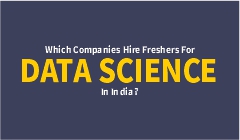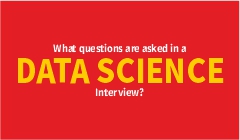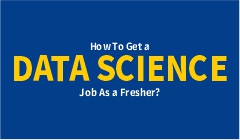
Data science is emerging as one of the most sought-after career options in India, with sectors from IT to finance, healthcare, retail, and e-commerce utilizing data to make intelligent business decisions. The increasing need for skilled data professionals has encouraged numerous freshers to wonder: Which Indian companies employ freshers as data scientists?
The silver lining is that there are multiple organizations that actively recruit entry-level candidates with the perfect mix of analytical mindset, technical aptitude, and problem-solving skills. That being said, before we get into the list of industries and roles, we need to get an idea of the scope, hiring trends, and what companies require in data science freshers.
Herein, we discuss:
The future of data science hiring in India
Let us start by learning why data science is an up-and-coming career for freshers in India.
Why Data Science is a Promising Job Opportunity for Freshers
Data science is popularly known as the "oil of the digital age" as data powers everything, right from customer interaction to product innovation. In India, firms are spending big bucks on data analytics, artificial intelligence, and machine learning to combat competition.
Data science provides the following benefits for freshers:
Current Trends in Hiring Freshers in Data Science in India
The recruitment process for freshers in data science has undergone a fast-paced change. It is not only hiring seasoned professionals but also investing in young professionals who can be trained and shaped to suit their organizational requirements.
Major recruitment trends are:
Skills Recruiters Search for in Data Science Freshers
Before making a hiring decision, companies assess some technical and non-technical skills in freshers. Freshers possessing these skills boost their hiring prospects.
Technical Skills
Soft Skills
Types of Companies That Hire Freshers for Data Science in India
Freshers also wonder if only IT companies recruit data science graduates. The fact is that data science has found its way into various industries, and freshers can get opportunities in various sectors.
1. IT & Software Companies
Indian tech companies are the biggest hirers of freshers in data science. They recruit for junior data analyst, business intelligence associate, and AI/ML engineer.
2. E-commerce & Retail
E-commerce websites and retail chains apply data science to customer behavior, personalize suggestions, and optimize supply chains. They recruit freshers for the role of data analytics and predictive modeling.
3. Banking, Financial Services & Insurance (BFSI)
Banks and financial institutions use data science to detect fraud, credit score, and manage risks. Data analysts and risk modelers are mostly recruited as freshers.
4. Healthcare & Pharmaceuticals
Data science in healthcare companies is applied in patient analytics, medical research, and drug development. Freshers with domain expertise can begin as health data analysts.
5. Telecom Sector
Telecom players utilize customer usage patterns and network optimization through data science. Freshers are hired for predictive analytics and customer churn analysis positions.
6. Startups & Emerging Tech Companies
AI, fintech, edtech, and healthtech startups are now increasingly hiring freshers as they are cost-efficient and flexible.
7. Consulting Firms
Consulting firms employ data science freshers to work on client assignments across segments such as digital transformation, customer insights, and predictive analytics.
Freshers' Job Roles in Data Science
Freshers in data science are typically recruited by companies with junior or support roles. These roles expose the candidates to live projects and enable them to gain expertise.
In-demand entry-level data science jobs are:
Data Science Freshers' Salary Trends in India
Salaries are one of the most important considerations for freshers looking to join the field of data science. Although the pay scale differs across the company, geography, and skill set, data science freshers tend to have better salaries compared to their traditional IT counterparts.
Note: Salaries rise drastically with experience, with experienced data scientists earning ₹15–25 LPA or more in India.
How Freshers Can Enhance Their Hired Chances
Freshers should implement the correct strategies to secure their first data science job.
Action steps are:
Future of Data Science Recruitment in India
The future is bright for new entrants into the data science sector in India. With the Indian market embracing artificial intelligence and sophisticated analytics at a fast rate, new entrants can look forward to:
Conclusion
So, which companies hire freshers for data science in India? The answer is: IT firms, e-commerce giants, BFSI companies, healthcare organizations, telecom providers, startups, and consulting firms are all actively hiring freshers. The key is to have the right skills, strong projects, and a learning mindset.
For freshers, data science is not only a job—it's a career with long-term growth, challenging opportunities, and international exposure. With proper preparation and training, freshers can surely step into this high-demand industry and establish a prosperous career in data science.

Data science has emerged as one of India's most sought-after career options and worldwide. As companies increasingly depend on data-driven decision-making, the need for data scientists has never been higher. But cracking a data science interview is not that simple. The hiring managers want to hire candidates who possess good technical skills in addition to problem-solving skills, communication skills, and domain knowledge.
If you're interviewing for a data science position in India, one of the most frequent questions that might come up is: What kinds of questions are data science interview questions? The reality is that data science interviews usually consist of questions on statistics, machine learning, programming, SQL, data visualization, probability, business case studies, and behavioral competencies.
In this post, we will thoroughly discuss the most frequently asked questions in a data science interview, how to respond to them, and tips for proper preparation. This guide will inform you about various phases of a data science interview and increase your probability of getting your dream job.
Why Preparing for Data Science Interview Questions is Important?
Data science interviews aim to assess theoretical knowledge and practical application skills. Most technically skilled candidates fail because they are unable to explain their thought process. Conversely, some candidates lack robust problem-solving methods despite having a command of coding.
Through the proper preparation with a clear strategy and the knowledge of the most frequently asked data science interview questions, you can:
Types of Data Science Interview Questions
During a typical data science interview process, questions are segregated into various categories:
Common Statistics and Probability Questions in Data Science Interviews
Statistics is the foundation of data science. Interviewers mostly assess how good you are at statistical ideas since they are used to build models and analyze data. Some of the usual questions are:
Study Tip: Refresh your knowledge on descriptive statistics, inferential statistics, hypothesis testing, probability distributions, and sampling techniques.
Machine Learning Questions in Data Science Interviews
Machine learning is probably the most important topic area where you will encounter technical questions. Companies are interested in understanding how well you grasp algorithms and whether you can use them to solve business issues.
Some common machine learning interview questions are:
Programming and Coding Questions in Data Science Interviews
Because data scientists must work with big datasets, programming skills are compulsory. The most frequent interview questions come in the form of Python, R, or SQL.
Sample Python coding interview questions:
Create a Python function that returns the second-largest element from a list.
SQL-based interview questions:
Data scientists waste countless hours cleaning and prepping datasets. Interviewers would typically ask utilitarian-type questions such as:
Case Study and Business Problem Questions
Most companies assess how candidates approach real business problems with the help of data science. They test critical thinking, problem-solving, and story skills through these questions.
Some examples of business case questions:
Data Visualization and Communication Questions
Data scientists should not only analyze, but also communicate insights well. Anticipate being asked questions like:
Behavioral and HR Questions in Data Science Interviews
Beyond technical skills, companies also put your teamwork, leadership, and problem-solving thinking to the test. Some popular behavioral questions are:
Tips to Prepare for Data Science Interview Questions
Final Thoughts
Indian data science interviews are very competitive, and the questions posed there evaluate your technical, analytical, and communication skills. Whether statistics, machine learning, SQL, programming, or business case studies, it takes only the best preparation to differentiate yourself from other applicants.
By rehearsing the most frequently asked data science interview questions and preparing well-structured answers, you will be able to confidently encounter interviews and acquire your ideal job as a data scientist in India.

Introduction
The demand for data scientists is booming worldwide, making data science one of the most sought-after careers in today’s tech industry. However, as a fresher without industry experience, breaking into this competitive field can feel challenging. The good news? It’s absolutely possible to land a data science job as a fresher with the right skills, portfolio, and job-hunting strategies. Employers value practical skills, projects, and problem-solving ability more than just degrees. In this guide, we’ll explore step-by-step how freshers can enter the data science job market and stand out to recruiters.
Quick Answers – How to Get a Data Science Job as a Fresher?
Why Data Science is a Great Career Option for Freshers
Data science is one of the most rapidly expanding career fields, with uses in every industry from healthcare to e-commerce. Here's why you should begin your career here:
Strong demand: Businesses require experts to interpret big data.
Good salaries: Even new data scientists receive competitive salaries.
Several career directions: You can specialize in AI, machine learning, NLP, or analytics.
Skill development: Ongoing learning keeps your career current.
Step-by-Step Guide to Landing a Data Science Job as a Fresher
1. Familiarize Yourself with the Data Science Job Market
Prior to learning skills, know about the job roles:
Data Analyst – Handles structured data for report generation and insights.
Junior Data Scientist – Handles small machine learning projects.
Business Intelligence Analyst – Deals with business acumen coupled with data analytics.
Machine Learning Engineer (Entry Level) – Handles elementary ML model development.
Tip: Being a fresher, applying for a Data Analyst or Junior Data Scientist can be an achievable entry point.
2. Master the Core Data Science Skills
Hiring managers pay more attention to technical skills than work experience. Freshers need to develop a solid set of skills in:
Technical Skills:
Programming: Python (Pandas, NumPy, Scikit-learn), R, or Julia.
Data Analysis: SQL for querying databases.
Statistics & Mathematics: Probability, hypothesis testing, regression.
Data Visualization: Matplotlib, Seaborn, Tableau, Power BI.
Machine Learning: Supervised, unsupervised, and basic deep learning.
Soft Skills:
3. Build a Strong Project Portfolio
Employers appreciate work evidence. Your biggest strength as a fresher could be your portfolio.
Ideas for Beginner Data Science Projects:
Best Practices:
4. Become Certified in Data Science
Certifications are not obligatory, but they enhance your credibility as a fresher. Seek certificates in:
Potential employers shortlist candidates who have certified skills from known training programs.
5. Open-Source & Competitions
Kaggle is a great place to develop real-world problem-solving skills.
Advantages of Kaggle & Open-Source:
6. Create a Job-Conquering Resume
As a fresher, you don't have work experience, but you can still produce a winning resume:
7. Establish Your LinkedIn Profile
Recruiters frequently discover freshers via LinkedIn.
LinkedIn Optimization Tips
Use "Aspiring Data Scientist" or "Entry-Level Data Analyst" in your title.
8. Network with Industry Experts
Networking can allow freshers to avoid conventional job applications.
How to Network:
9. Apply for Internships & Entry-Level Positions
Don't wait for the "ideal" job. Apply to:
10. Interview Preparation
Data science interviews usually consist of:
Fresher Interview Questions that are commonly asked:
11. Keep Learning & Get Updated
Data science is very dynamic. Freshers need to keep up with:
Mistakes Freshers Tend to Make While Looking for a Data Science Job
Estimated Time to Get Hired as a Fresher in Data Science
Total: Approximately 6–10 months with persistent effort.
Final Thoughts
To land a data science role as a fresher takes persistence, talent, and intelligent job searching. Experience does provide an advantage, but employers appreciate real-world knowledge, portfolio work, and problem-solving skills more than years of experience. If you concentrate on learning, constructing, networking, and presenting work, you will be able to start your data science career successfully.